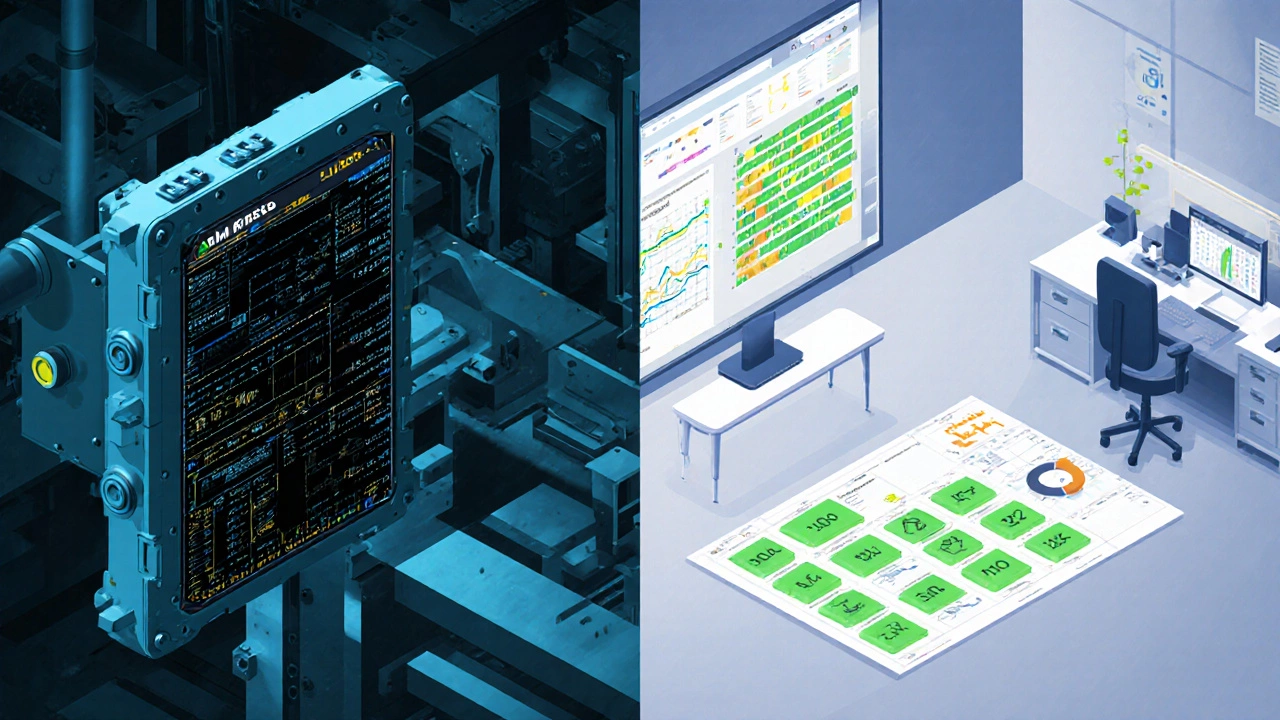MES vs MOM Comparison Tool
Compare MES and MOM
Select a comparison category to see how MES and MOM differ for that specific aspect.
Select a category above
This tool will display a comparison of MES versus MOM based on your selection.
When you hear MES (Manufacturing Execution System) is a software layer that sits between the shop floor and the enterprise, you might wonder how it differs from MOM (Manufacturing Operations Management) - another term you see in factory‑floor meetings. Both aim to make production smoother, but they focus on different pieces of the puzzle. This guide breaks down the two, shows where they overlap, and helps you decide which one fits your plant.
What exactly is an MES?
Manufacturing Execution System is a real‑time system that records, monitors, and controls the execution of manufacturing operations. Think of it as the nervous system of a factory: it captures machine status, work‑order progress, labor allocation, and quality checkpoints the moment they happen. By feeding this data back to supervisors, an MES enables immediate adjustments - for example, rerouting a batch when a machine goes down.
What does MOM cover?
Manufacturing Operations Management takes a broader view. It bundles together the functions of an MES but also adds higher‑level planning, scheduling, inventory control, and performance analytics. MOM is often described as the “umbrella” that includes MES, advanced planning and scheduling (APS), quality management, and even some elements of enterprise resource planning (ERP).
Core functions compared side by side
- Real‑time shop‑floor data capture: Both MES and MOM collect this, but MES is usually more granular (machine‑level).
- Production scheduling: MOM typically incorporates advanced scheduling tools, while MES often follows a schedule handed down from an external system.
- Quality management: MES logs defect data; MOM adds statistical process control, root‑cause analysis, and corrective‑action workflows.
- Inventory & material tracking: MOM links to warehouse modules; MES may only track material at the point of use.
- Performance analytics: MOM delivers KPI dashboards that span the whole operation; MES focuses on OEE (Overall Equipment Effectiveness) at the machine level.
Architecture and technology stack
Both systems rely on modern technologies like the Internet of Things (IoT), cloud services, and OPC-UA interfaces for machine communication. An MES often runs on a lightweight server close to the shop floor, sometimes even on edge devices, to guarantee low latency. MOM, being broader, may sit in the corporate data center or on a public cloud, pulling data from the MES, ERP, and other enterprise systems.

Integration points you’ll encounter
When you start wiring up a new system, you’ll see a handful of familiar acronyms:
- SCADA: Supervisory Control and Data Acquisition systems feed raw sensor data to the MES.
- ERP: The ERP provides the master production schedule that the MES executes.
- Industry 4.0: Both MES and MOM can be part of a smart‑factory strategy, leveraging digital twins and AI‑driven predictive maintenance.
Benefits of choosing the right tool
Picking the correct approach can shave weeks off a product launch. An MES alone can give you instant visibility, reduce scrap, and improve OEE by 5‑10%. Adding MOM on top brings down lead time through better scheduling, tighter inventory control, and unified reporting, often delivering a 15‑20% boost in overall throughput.
MES vs MOM - quick comparison
| Aspect | MES | MOM |
|---|---|---|
| Scope | Shop‑floor execution | Enterprise‑wide operations |
| Primary Goal | Real‑time data capture & control | Planning, scheduling, analytics |
| Typical Users | Operators, floor supervisors | Production planners, quality managers, executives |
| Integration Focus | SCADA, PLCs, edge devices | ERP, APS, BI tools, IoT platforms |
| Implementation Complexity | Medium - often phased per line | High - requires cross‑functional alignment |
How to decide which one you need
If your plant already has a solid ERP and you only need to tighten up shop‑floor visibility, start with an MES. Deploy it on one line, measure OEE gains, then expand. If you’re building a new facility or undergoing a digital transformation, consider a MOM suite that bundles MES functionality with advanced planning and quality modules. A good rule of thumb: MES first, MOM later - unless you have the budget and change‑management capacity to go big from day one.
Common pitfalls and how to avoid them
- Over‑engineering: Buying a MOM suite for a small workshop can be wasteful. Begin with a lightweight MES and scale.
- Data silos: If the MES doesn’t talk to ERP, you’ll end up with duplicate entry work. Choose solutions with open APIs.
- Change resistance: Operators may ignore new screens. Involve them early, keep interfaces simple, and show quick wins.
- Ignoring cybersecurity: Both MES and MOM expose plant data. Apply network segmentation and regular patching.
Future trends shaping MES and MOM
By 2030, most manufacturers will embed AI into both layers. MES will auto‑adjust setpoints based on predictive models, while MOM will run scenario planning in the cloud, allowing you to test new product mixes without touching the floor. Keep an eye on standards like ISA‑95, which continue to define clear boundaries between ERP, MOM, and MES.
Frequently Asked Questions
Is an MES a subset of MOM?
Yes. An MES handles real‑time execution on the shop floor, and MOM includes those capabilities while adding planning, analytics, and broader integration.
Can I run an MES without an ERP?
You can, but you’ll miss out on synchronized scheduling. Many manufacturers start with a standalone MES and later link it to an ERP for full alignment.
What’s the typical ROI for implementing an MES?
Studies from the Manufacturing Enterprise Solutions Association (MESA) show an average ROI of 12‑18% within the first 18months, driven mainly by reduced scrap and improved OEE.
Do MOM platforms support cloud deployment?
Most modern MOM suites are offered as SaaS or hybrid cloud solutions, allowing easy scaling and integration with other cloud‑based analytics tools.
How does Industry 4.0 relate to MES and MOM?
Industry 4.0 provides the data highways (IoT, digital twins) that feed both MES and MOM. Together they enable the closed‑loop automation that defines a smart factory.











Write a comment